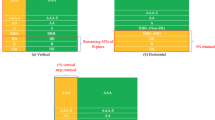Abstract
This paper studies the impact of bank monitoring on the risk of US equity REITs. Using a unique, hand-collected data sample of mortgage balances, I show that bank screening and monitoring of REIT assets via utilizing secured mortgage financing (vs unsecured, public debt) lowers the overall company risk of a REIT. At the asset level, screening results in retail and office assets with higher acquisition values and located in primary markets, i.e., more transparent assets, being pledged as collateral. Further, I find evidence consistent with the role of lender monitoring for secured mortgage loans and show that properties located in closer proximity to a REIT’s headquarters are more likely to be pledged as collateral for a mortgage.
Similar content being viewed by others
Notes
Additional property characteristics that a bank would consider such as Lease Terms and Net Operating Income are not observed in the data sample.
The look back period used by Kenneth French for the Momentum factor is 12 months. A portfolio is formed at the end of month t-1
References
Agarwal, S., & Hauswald, R. (2010). Distance and private information in lending. Review of Financial Studies, 23(7), 2757–2788.
Agarwal, S., Green, R. K., Rosenblatt, E., & Yao, V. (2015). Collateral pledge, sunk-cost fallacy and mortgage default. Journal of Financial Intermediation, 24(4), 636–652.
Allen, L. and Letdin, M. (2015). Decomposition of debt and the road to reit returns. Working P.
Ambrose, B. W., & Nourse, H. O. (1993). Factors influencing capitalization rates. Journal of Real Estate Research, 8(2), 221.
Baker, M., & Wurgler, J. (2002). Market timing and capital structure. Journal of Finance, 57(1), 1–32.
Bali, T. G., & Cakici, N. (2008). Idiosyncratic volatility and the cross section of expected returns. The Journal of Financial and Quantitative Analysis, 43(1), 29–58.
Besanko, D., & Thakor, A. V. (1987). Collateral and rationing: Sorting equilibria in monopolistic and competitive credit markets. International Economic Review, 28(3), 671–689.
Boot, A. W. A., Thakor, A. V., & Udell, G. F. (1991). Secured lending and default risk: Equilibrium analysis, policy implications and empirical results. Economic Journal, 101(406), 458–472.
Booth, J. R. (1992). Contract costs, bank loans, and the cross-monitoring hypothesis. Journal of Financial Economics, 31(1), 25–41.
Brown, D. T., & Riddiough, T. J. (2003). Financing choice and liability structure of real estate investment trusts. Real Estate Economics, 31(3), 313–346.
Chan, Y.-S., & Kanatas, G. (1985). Asymmetric valuations and the role of collateral in loan agreements. Journal of Money, Credit and Banking, 17(1), 84–95.
Chan, Y., & Thakor, A. (1987). Collateral and competitive equilibria with moral hazard and private information. The Journal of Finance, 42(2), 345–363.
Chichernea, D., Miller, N., Fisher, J., Sklarz, M., & White, B. (2008). A cross-sectional analysis of cap rates by msa. Journal of Real Estate Research, 30(3), 249–292.
Colla, P., Ippolito, F., & Li, K. (2013). Debt specialization. The Journal of Finance, 68(5), 2117–2141.
Deng, Y., Devos, E., Rahman, S., and Tsang, D. (2015). The role of debt covenants in the investment grade bond market – the reit experiment. The Journal of Real Estate Finance and Economics, 1–21.
Faulkender, M., & Petersen, M. (2006). Does the source of capital affect capital structure? Review of Financial Studies, 19(1), 45–79.
Giambona, E., Mello, A. S., and Riddiough, T. J. (2012). Collateral and the limits of debt capacity: Theory and evidence. working paper available at SSRN: http://ssrn.com/abstract=2039253.
Giambona, E., Golec, J., and Schwienbacher, A. (2013). Debt capacity of real estate collateral. Real Estate Economics.
Graham, J. R. (2000). How big are the tax benefits of debt? The Journal of Finance, 55(5), 1901–1941.
Harrison, D. M., Panasian, C. A., & Seiler, M. J. (2011). Further evidence on the capital structure of reits. Real Estate Economics, 39(1), 133–166.
Jimnez, G., Salas, V., & Saurina, J. (2006). Determinants of collateral. Journal of Financial Economics, 81(2), 255–281.
Knyazeva, A., & Knyazeva, D. (2012). Does being your banks neighbor matter? Journal of Banking & Finance, 36(4), 1194–1209.
Liu, C. H., Liu, P., and Zhang, Z. (2015). Real assets, liquidation value and choice of financing. Real Estate Economics, Forthcoming.
Miller, M. H., & Modigliani, F. (1961). Dividend policy, growth, and the valuation of shares. The Journal of Business, 34(4), 411–433.
Morellec, E. (2001). Asset liquidity, capital structure, and secured debt. Journal of Financial Economics, 61(2), 173–206.
Park, C. (2000). Monitoring and structure of debt contracts. The Journal of Finance, 55(5), 2157–2195.
Rajan, R., & Winton, A. (1995). Covenants and collateral as incentives to monitor. The Journal of Finance, 50(4), 1113–1146.
Rauh, J. D., & Sufi, A. (2010). Capital structure and debt structure. Review of Financial Studies, 23(12), 4242–4280.
Riddiough, T. J. and Steiner, E. (2015). One size does not fit all: Reit capital structure and firm value. Working Paper.
Stiglitz, J. E., & Weiss, A. (1981). Credit rationing in markets with imperfect information. The American Economic Review, 71(3), 393–410.
Stulz, R., & Johnson, H. (1985). An analysis of secured debt. Journal of Financial Economics, 14(4), 501–521.
Sun, L., Titman, S. D., and Twite, G. J. (2014). Reit and commercial real estate returns: A postmortem of the financial crisis. Real Estate Economics.
Acknowledgments
I’d like to thank James B. Kau, an anonymous referee, Linda Allen, CF Sirmans, Ko Wang, Su Han Chan, Timothy Riddiough, Joseph Weintrop, David Dennis, Moussa Diop, Vladimir Khasin, Rinat Letdin and seminar participants of Baruch College Finance Department Seminar, Midwest Finance Association Meetings 2015, American Real Estate Society Meetings 2015 and American Real Estate and Urban Economics Association Meetings 2016 for their helpful feedback and comments. Alev Yalman and Paul Dunn provided excellent research assistance. The remaining errors are my own.
Author information
Authors and Affiliations
Corresponding author
Rights and permissions
About this article
Cite this article
Letdin, M. Under the Lender’s Looking Glass. J Real Estate Finan Econ 55, 435–456 (2017). https://doi.org/10.1007/s11146-016-9561-4
Published:
Issue Date:
DOI: https://doi.org/10.1007/s11146-016-9561-4




